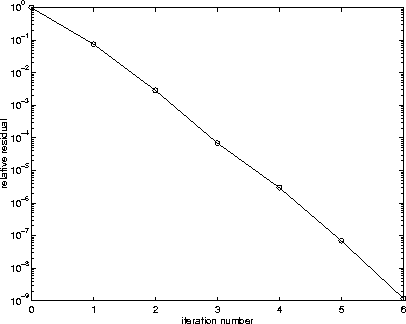
| MATLAB Function Reference | Search Help Desk |
| polyfit | Examples See Also |
p = polyfit(x,y,n) [p,s] = polyfit(x,y,n)
p = polyfit(x,y,n)
finds the coefficients of a polynomial p(x) of degree n that fits the data, p(x(i)) to y(i), in a least squares sense. The result p is a row vector of length n+1 containing the polynomial coefficients in descending powers: 
[p,s] = polyfit(x,y,n)
returns the polynomial coefficients p and a structure S for use with polyval to obtain error estimates or predictions. If the errors in the data Y are independent normal with constant variance; polyval will produce error bounds that contain at least 50% of the predictions.
This example involves fitting the error function, erf(x), by a polynomial in x. This is a risky project because erf(x) is a bounded function, while polynomials are unbounded, so the fit might not be very good.
First generate a vector of x-points, equally spaced in the interval  ; then evaluate
; then evaluate erf(x) at those points.
x = (0: 0.1: 2.5)'; y = erf(x);The coefficients in the approximating polynomial of degree 6 are
p = polyfit(x,y,6)
p =
0.0084 -0.0983 0.4217 -0.7435 0.1471 1.1064 0.0004
There are seven coefficients and the polynomial is
f = polyval(p,x);
A table showing the data, fit, and error is
table = [x y f y-f]
table =
0 0 0.0004 -0.0004
0.1000 0.1125 0.1119 0.0006
0.2000 0.2227 0.2223 0.0004
0.3000 0.3286 0.3287 -0.0001
0.4000 0.4284 0.4288 -0.0004
...
2.1000 0.9970 0.9969 0.0001
2.2000 0.9981 0.9982 -0.0001
2.3000 0.9989 0.9991 -0.0003
2.4000 0.9993 0.9995 -0.0002
2.5000 0.9996 0.9994 0.0002
So, on this interval, the fit is good to between three and four digits. Beyond this interval the graph shows that the polynomial behavior takes over and the approximation quickly deteriorates.
x = (0: 0.1: 5)'; y = erf(x); f = polyval(p,x); plot(x,y,'o',x,f,'-') axis([0 5 0 2])The M-file forms the Vandermonde matrix, V, whose elements are powers of x.

 The M-file can be modified to use other functions of x as the basis functions.
The M-file can be modified to use other functions of x as the basis functions.
polyval Polynomial evaluation
roots Polynomial roots